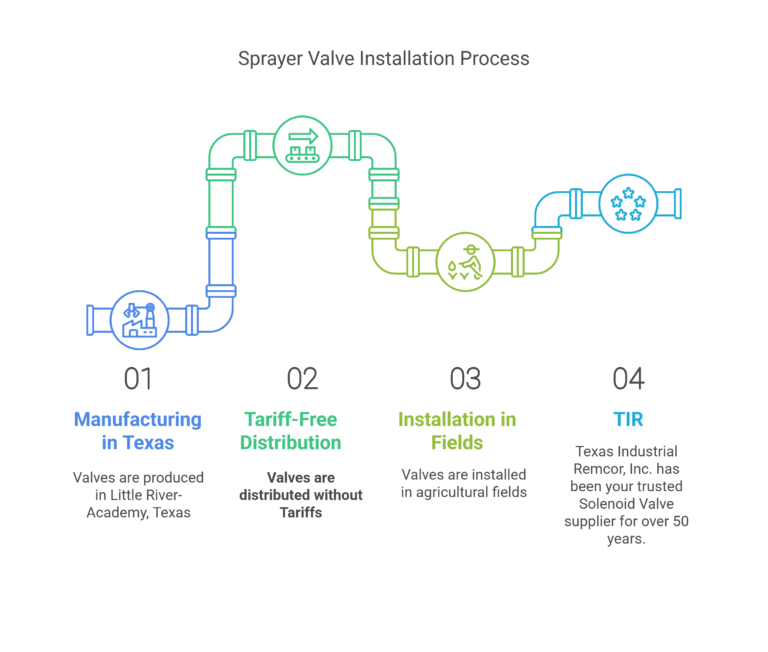What does a 2 way valve do?
Understanding Solenoid Valves
Basics of Solenoid Valve Operation
A solenoid valve is an electromechanically operated valve used to control the flow of various media, such as liquids or gases, through a system. It consists of a solenoid coil mounted atop a valve body, which includes components like springs, a plunger, and a diaphragm.
When electricity is applied to the solenoid coil, it generates a magnetic field that moves the plunger, opening or closing the valve. In a 2-way solenoid valve, there are two pipe connections: an inlet called the cavity port and an outlet called the body orifice port. When the valve is energized, the plunger opens, allowing media to flow through the cavity port and out the body orifice port. When the power is turned off, the orifice closes, stopping the flow (Solenoid Solutions Inc.).
Understanding these basics can help you select the right 2 way solenoid valve for your agricultural needs, ensuring efficient and reliable crop spraying.
Importance of Proper Maintenance
Proper maintenance of solenoid valves is crucial for ensuring reliable performance and extending the lifespan of the valve. Regular maintenance tasks include replacing worn-out components and keeping the valve parts clean and free of debris. Indicators such as excessive noise, leakage, or sluggish operation suggest that the valve needs to be cleaned and inspected for potential issues.
A consistent maintenance schedule can prevent unexpected failures and maintain predictable valve operation. Generally, solenoid valves should be maintained every 6 to 12 months, depending on the specific application and manufacturer recommendations.
| Maintenance Task | Frequency | Importance |
|---|---|---|
| Cleaning valve parts | Every 6 to 12 months | Prevents debris build-up and ensures smooth operation |
| Replacing worn-out components | As needed | Extends valve lifespan and prevents failures |
| Inspecting for leaks | Regularly | Ensures reliable operation and safety |
For more detailed information on maintenance procedures, you can refer to our maintenance guide for solenoid valves.
Proper understanding and maintenance of your solenoid valves can significantly enhance their performance and reliability. Explore our other articles to learn more about what is the difference between a 2 way and 3 way solenoid valve? and how does a 2 way control valve work?.
Selecting the Right Solenoid Valve
Choosing the right solenoid valve for your crop spraying needs is crucial for efficient and reliable performance. Key factors include material selection and safety considerations.
Material Selection for Different Applications
The material of the solenoid valve is vital for ensuring compatibility with the media being regulated and the environmental conditions it will face. Different materials offer varying levels of chemical resistance, durability, and heat tolerance.
| Material | Chemical Resistance | Heat Tolerance | Common Applications |
|---|---|---|---|
| Plastic | Good | Poor with hot fluids | General-purpose, non-corrosive fluids |
| Steel | Excellent | High | Industrial, corrosive environments |
| Brass | Good | Moderate | Water, oils, air |
| Bronze | Good | Moderate | Marine applications, water |
| Aluminum | Fair | Moderate | Lightweight applications |
Figures courtesy Solenoid.
For crop spraying, where the valve may be exposed to various chemicals and harsh outdoor conditions, metal solenoid valves like brass or stainless steel are recommended. These materials offer superior durability and resistance to corrosion, ensuring a longer lifespan and fewer maintenance issues.
Safety Considerations and Specifications
Safety considerations are paramount when selecting a solenoid valve for agricultural applications. Ensuring the valve meets specific safety standards and guidelines is essential to prevent malfunctions and ensure the safety of your crops and equipment.
- Working Principle: Understand the valve’s operating mechanism to ensure it matches your system’s requirements.
- Voltage: Choose the appropriate voltage rating compatible with your power supply.
- Valve Size and Threading: Ensure the valve size and threading match your existing system for a secure fit.
- Pressure and Temperature Range: Verify the valve can handle the pressure and temperature ranges of your application.
- IP Rating: Select a valve with an adequate IP rating to withstand environmental conditions like dust and water.
- Response Time: Consider the response time of the valve to ensure it meets the operational needs of your system.
For applications involving fluids meant for human consumption, such as irrigation for food crops, stainless steel valves are advisable due to their safety and corrosion resistance properties.
By carefully considering these factors, you can select the best 2 way solenoid valve that meets your agricultural needs. For more information on the differences between solenoid valves, visit our article on what is the difference between a 2 way and 3 way solenoid valve?.
Types of Solenoid Valves
Understanding the different types of solenoid valves available is crucial for selecting the right one for your agricultural needs. Here, we explore the distinctions between 2-way, 3-way, 4/2-way, and 5/2-way solenoid valves.
2-Way vs. 3-Way Solenoid Valves
2-way solenoid valves are simple yet highly effective. These valves consist of two ports: an inlet port “A” and an outlet port “AB”. They are commonly referred to as isolation valves and are ideal for basic on/off applications. In many process safety systems, 2-way valves can immediately stop fluid flow to a specific location in the event of an emergency.
| Valve Type | Ports | Common Use | Advantages |
|---|---|---|---|
| 2-Way | A, AB | On/Off applications | Simple design, quick to activate |
| 3-Way | A, B, AB | Diverting/Mixing fluids | Can mix fluids from two inlets, cost-effective |
3-way solenoid valves, on the other hand, feature three ports: “A,” “B,” and “AB”. These valves can either divert the flow of fluids or mix fluids from two inlets delivered through to a single outlet. For example, when used as mixing valves, fluids from inlet port A and B are mixed inside the valve body and subsequently transmitted out through port AB. The ability to mix fluids makes 3-way valves ideal for heating and cooling various media such as water, oils, and chemicals.
For further details on the differences between these valves, visit our page on what is the difference between a 2 way and 3 way solenoid valve.
4/2-Way and 5/2-Way Solenoid Valves
4/2-way solenoid valves consist of four ports and two states. These valves are typically used in more complex applications, such as controlling the movement of actuators in pneumatic systems. They allow for more precise control compared to basic 2-way or 3-way valves.
5/2-way solenoid valves are even more advanced, featuring five ports and two states, with two inlets, two outlets, and one exhaust port (Valves Actuator). These valves provide enhanced control over the flow of liquids and gases, making them suitable for sophisticated control systems.
| Valve Type | Ports | Common Use | Advantages |
|---|---|---|---|
| 4/2-Way | Four | Pneumatic control | Precise control of actuators |
| 5/2-Way | Five | Advanced control systems | More control over flow, versatile |
For more insights into how these valves function and their applications, explore our guide on how does a 2 way control valve work.
Selecting the appropriate solenoid valve can significantly impact the efficiency and safety of your agricultural setup. Whether you need a basic 2-way valve for simple on/off applications or a more complex 5/2-way valve for advanced control, understanding these options will help you make an informed decision. For more information on 2-way solenoid valves, visit our dedicated page on the 2 way solenoid valve.
Applications and Usage
Industrial Applications and Efficiency
Understanding the role of a 2 way solenoid valve in industrial applications can significantly enhance your farming operations. These valves are essential for controlling the flow of various media, including water, air, and chemicals, through an automated system. They are electromechanically operated, consisting of a solenoid coil atop a valve body with springs, a plunger, and a diaphragm.
In agriculture, particularly in crop spraying, the efficiency and reliability of solenoid valves can directly impact the effectiveness of your irrigation and fertilization systems. A 2 way solenoid valve can be paired with IoT controllers, air accumulators, timers, and switches to automate and streamline these processes. This level of automation not only improves efficiency but also reduces labor costs and minimizes human error.
| Application | Media Controlled | Benefits |
|---|---|---|
| Crop Spraying | Water, Fertilizers, Pesticides | Precise control, reduced waste |
| Irrigation Systems | Water | Automated scheduling, water conservation |
| Fertilization Systems | Liquid Fertilizers | Uniform distribution, increased crop yield |
For more information on optimizing your irrigation systems, visit our article on how does a 2 way control valve work.
Pneumatic Solenoid Valves and Control Systems
Pneumatic solenoid valves are commonly used in control systems to manage the flow of air. These valves are ideal for applications requiring rapid switching and high accuracy, which are often necessary in modern agricultural machinery.
By integrating pneumatic solenoid valves into your farming equipment, you can achieve better control over various pneumatic actuators and devices. These valves can be employed in seed planting machines, automated greenhouse systems, and even in livestock feeding mechanisms.
| Application | Controlled Device | Advantages |
|---|---|---|
| Seed Planting | Pneumatic Actuators | Precision planting, increased efficiency |
| Greenhouse Automation | Ventilation, Humidity Control | Optimized growing conditions, energy savings |
| Livestock Feeding | Automated Feeders | Consistent feeding schedules, reduced labor |
Pneumatic solenoid valves are known for their durability and low maintenance requirements, making them a cost-effective choice for long-term agricultural use. For a deeper understanding of how these valves can benefit your farm, explore our guide on what is the difference between a 2 way and 3 way solenoid valve.
Proper installation and maintenance are crucial to avoid valve failure and ensure reliable performance. Regular checks and timely repairs can prolong the life of your solenoid valves and keep your systems running smoothly.
By utilizing the right solenoid valves in your agricultural operations, you can achieve greater efficiency, reduce costs, and improve overall productivity. For more tips on maintaining your solenoid valves, refer to our comprehensive maintenance guide on 2 way solenoid valve.

